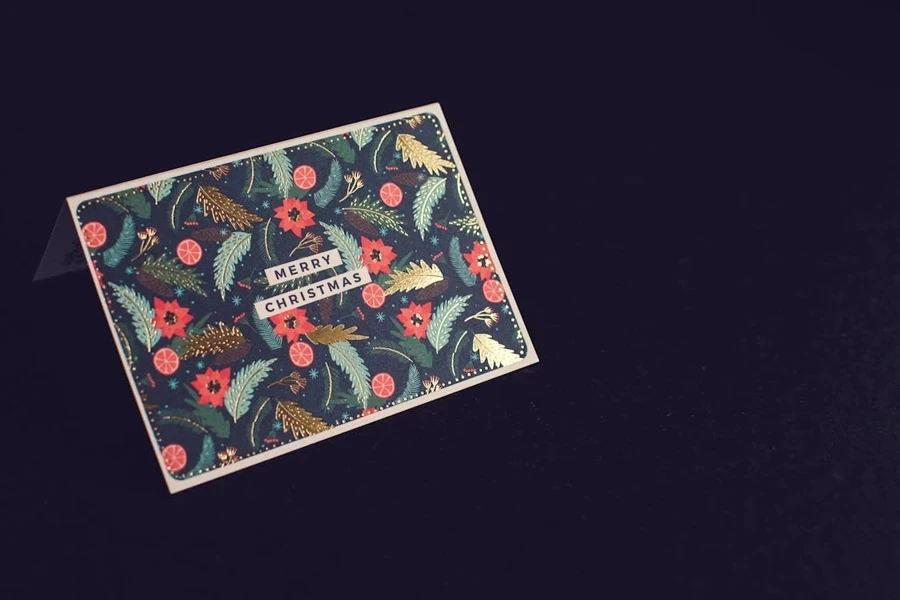Selecting the ideal Christmas cards in 2024 offers more than a seasonal greeting; it provides a strategic advantage in fostering relationships and enhancing brand perception. As preferences evolve and sustainability becomes crucial, companies must choose cards that resonate with both personal and professional contacts. These cards act as ambassadors of sentiment, weaving the traditional with the innovative to stand out in the festive flurry. Whether aiming to impress stakeholders with customized designs or to spread holiday cheer with eco-friendly options, the right card selection can significantly influence business relationships and personal connections alike.
Table of Contents
1. Variety and applications of Christmas cards
2. Overview of the 2024 Christmas card market
3. Criteria for choosing the right Christmas cards
4. Spotlight on leading Christmas card models for 2024
1. Variety and applications of Christmas cards

The landscape of Christmas cards continues to evolve, offering a rich tapestry of designs that cater to diverse preferences and purposes. The distinction between digital, traditional, and hybrid models highlights the adaptability of this festive staple.
Types of Christmas cards
The realm of Christmas cards is broadening, with digital, traditional, and hybrid models each serving distinct roles. Digital cards are gaining traction, harnessing the power of technology to deliver instant, customizable, and often interactive messages. They blend modern design aesthetics with the convenience of digital communication, catering to a tech-savvy audience that values efficiency and innovation.
Traditional cards remain beloved for their tangible nature and personal touch. They incorporate elements like hand-painted designs, fine papers, and intricate details such as embossing or foil accents. These cards resonate deeply on a personal level, often becoming keepsakes that carry sentimental value beyond the season.
Hybrid models are a fusion of digital and traditional elements, offering the best of both worlds. These cards might feature QR codes that link to personal messages or videos, combining the physical appeal of traditional cards with the interactive capabilities of digital formats.

Usage scenarios
The application of Christmas cards varies significantly between corporate and personal contexts, influencing both design and message. In corporate settings, cards are often used as a tool for strengthening relationships with clients and partners. The designs tend to be more formal and understated, conveying professionalism and seasonal greetings without being overly personal.
For personal use, cards are more intimate, often customized with family photos, personal anecdotes, or handcrafted designs. These personal touches make each card a unique expression of the sender’s personality and familial ties.
In both scenarios, the choice of a card can significantly affect the recipient’s perception. For instance, eco-conscious cards made from recycled materials or featuring sustainable themes are increasingly popular. They reflect the sender’s values and resonate with recipients who prioritize environmental responsibility.
This nuanced approach to selecting Christmas cards underscores their role not just as holiday greetings but as strategic tools for communication and relationship-building in both personal and business contexts. The trend towards more personalized, sustainable, and technologically integrated Christmas cards is likely to continue shaping how individuals and companies express their festive cheer.
2. Overview of the 2024 Christmas card market

As 2024 unfolds, the Christmas card market exhibits a notable shift towards minimalism and eco-conscious materials, reflecting broader societal trends towards sustainability and refined simplicity.
Current trends in design
The design trends within the Christmas card market are increasingly leaning towards minimalism. This approach not only caters to aesthetic preferences for simplicity but also aligns with eco-friendly practices, emphasizing less waste and the use of sustainable materials. Eco-conscious materials such as recycled paper or cards embedded with seeds that can be planted after use are becoming more prevalent. These materials appeal to environmentally aware consumers and businesses eager to demonstrate their commitment to sustainability. Additionally, designs are increasingly incorporating neutral palettes with pops of color to blend traditional festive elements with a modern twist, creating a visually appealing and contemporary feel.

Market demand projections
The demand for Christmas cards is projected to continue its growth trajectory, fueled by a resurgence in personal correspondence and an increasing trend towards personalized products. Market analysis predicts a steady increase in the consumption of both physical and digital Christmas cards, as they offer a tangible connection in an increasingly virtual world. This growth is particularly pronounced in sectors that value bespoke and artisanal products.
The digital card sector is also expanding rapidly. Innovations in this space include cards that combine digital convenience with traditional elements, like digital cards that can be printed at home. This hybrid approach caters to the desire for customization and immediacy in card-giving. The market’s expansion is supported by data indicating that consumers are willing to pay a premium for cards that are unique and customizable, which suggests a shift towards quality over quantity in card purchases.
This analysis of the Christmas card market in 2024 reveals a dynamic industry that is adapting to changing consumer preferences and technological advancements. The emphasis on sustainability and personalization is not only a response to consumer demand but also a reflection of broader societal shifts towards more mindful consumption. Companies that can innovate within these parameters are likely to find success in a competitive marketplace.
3. Criteria for choosing the right Christmas cards

Selecting the right Christmas card involves more than just picking a pretty design. It requires careful consideration of visual appeal, material quality, and the potential for personalization, all of which play pivotal roles in how the card aligns with the sender’s message and values.
Design considerations
The visual appeal of Christmas cards is paramount in making a lasting impression. A well-designed card not only captures attention but also communicates the intended sentiment effectively. Thematic consistency is crucial, as it ensures that the card’s design aligns with the traditional or contemporary themes that the recipient might appreciate. For instance, a minimalist design can convey elegance and sophistication, while a more vibrant and elaborate design might evoke a sense of joy and festivity. Ensuring that the design resonates with the recipient while staying true to the sender’s brand or personal style requires a balance of color, typography, and imagery that complements the message within.
Material and sustainability
The choice of materials reflects the sender’s commitment to sustainability and can influence the recipient’s perception of the card and, by extension, the sender. Eco-friendly materials such as recycled paper or biodegradable elements are increasingly popular, reflecting a growing consumer preference for products that minimize environmental impact. These materials not only reduce waste but also serve as a talking point, showcasing the sender’s environmental consciousness. Additionally, the quality of the paper, its texture, and durability contribute to the card’s overall feel, enhancing the tactile experience of the recipient.

Customization options
Personalization enhances the significance of Christmas cards, making them more memorable and valued. The ability to tailor cards to the recipient’s preferences or to include bespoke elements like personal messages, custom artwork, or even interactive features can turn a simple card into a keepsake. For businesses, customization allows for the incorporation of brand elements, such as logos or corporate colors, which reinforce brand recognition and strengthen business relationships during the holiday season.
Advanced digital tools and printing technologies have made it easier and more cost-effective to create customized cards, even for small-scale orders, allowing individuals and companies to offer a highly personalized touch without significant overhead.
By emphasizing these criteria—design, material quality, and customization options—individuals and businesses can choose Christmas cards that are not only visually appealing and environmentally responsible but also deeply personalized. These elements together ensure that the cards are not just seen as a holiday formality but as a meaningful expression of connection and goodwill.
4. Spotlight on leading Christmas card models for 2024

As the Christmas card industry evolves, 2024 showcases a vibrant selection of models that stand out due to their innovation in digital technology, excellence in traditional craftsmanship, and commitment to sustainability.
Review of top digital card innovations
The digital Christmas card market has seen remarkable innovations, particularly in the integration of technology that enhances personal interaction. Features like augmented reality, allowing recipients to view immersive, animated holiday scenes by scanning their cards with a smartphone, are setting new standards. Additionally, digital cards with customizable video messages are gaining popularity, as they offer a personal touch that can be enjoyed and shared across digital platforms. These innovations reflect a growing trend towards interactive and multimedia experiences in card giving, catering to a tech-savvy audience looking for memorable and engaging ways to convey their holiday greetings.
Best traditional card picks
Despite the rise of digital solutions, traditional Christmas cards remain highly valued for their tactile quality and artistic expression. 2024 highlights include cards from artisans who use time-honored techniques such as letterpress printing, hand-painting, and calligraphy. These cards are not only greetings but also pieces of art that recipients treasure well beyond the holiday season. Manufacturers like Simply to Impress stand out by offering high-quality paper options and intricate designs that cater to consumers looking for premium, classic card options. Their commitment to maintaining high standards in print quality and aesthetic detail makes their offerings particularly notable this year.

Eco-friendly choices
Sustainability continues to be a significant concern, with more consumers now preferring products that have minimal environmental impact. The market has responded with Christmas cards made from recycled materials and those embedded with seeds that can be planted after the holidays. Companies like Paper Culture and Greenvelope lead the way by offering attractive designs on 100% post-consumer recycled paper and emphasizing their commitment to environmental responsibility. These eco-friendly choices are becoming a decisive factor for many buyers, reflecting a broader trend towards sustainability in consumer products.
The offerings for 2024 highlight a dynamic Christmas card market where innovation, tradition, and sustainability play crucial roles. Whether through cutting-edge digital features, exquisite craftsmanship, or eco-conscious materials, these models offer varied options to meet the diverse needs and preferences of today’s consumers.
Conclusion
Experts currently value the global greeting cards market at US$ 23 billion in 2020, and they expect it to shrink to US$ 20.9 billion by 2026. This decline is projected at a -1.7% compound annual growth rate (CAGR) from 2020 to 2026. Key segments such as Christmas and New Year cards are anticipated to experience a -2.5% CAGR over the next seven years. The U.S. remains the largest market, valued at $7.3 billion in 2021, while China’s market is forecasted to decline to $1.1 billion by 2026. Other significant markets, including Japan and Canada, are also expected to see negative CAGRs of -1.8% and -2% respectively. Despite competition from digital alternatives like e-cards and social media, a niche consumer base that prefers physical greeting cards continues to exist. However, the overall market faces a steady decline due to shifts in consumer preferences, demographics, and technological advancements.




